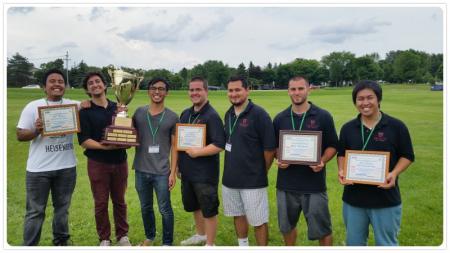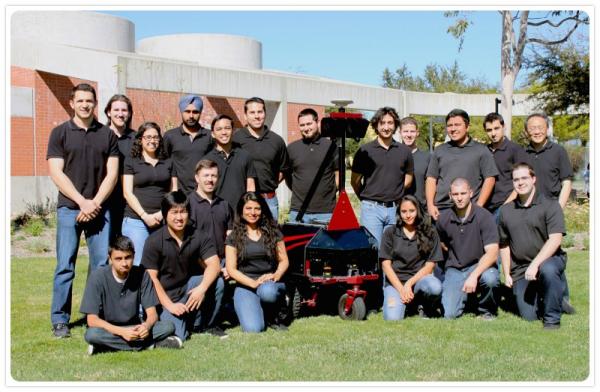 CECS teams had an outstanding record in the Intelligent Ground Vehicle Competition between 2011 and 2014, twice placing first and twice placing second, against an average of 40-50 teams from around the world. But the 2015 team’s win truly broke new ground.
CECS teams had an outstanding record in the Intelligent Ground Vehicle Competition between 2011 and 2014, twice placing first and twice placing second, against an average of 40-50 teams from around the world. But the 2015 team’s win truly broke new ground.
The competition calls for teams to design and build an autonomous unmanned robot that can negotiate a course with obstacles and perform certain assigned tasks. In the past, CSUN teams have focused less on a category called joint architecture for unmanned systems (JAUS) than on other categories in the competition (design, autonomous navigation). JAUS is a protocol for establishing communication between two units, whether the unit is the robot or a laptop running at the command station, for example. The handshaking protocol allows a commanding station to know the robot’s current location, speed, direction, etc., and in the autonomous robot field, JAUS is becoming very important.
While the mechanical engineering students who made up the 2015 team were well trained in LabVIEW programming, they determined that the JAUS programming would best be done in the C++ language. So they recruited three electrical and computer engineering students to take on that task, which made all the difference. CSUN took first place in the JAUS category (jumping from sixth the previous year), and that score, along with a strong showing in the autonomous navigation category, was enough to win them the grand prize.
 C.T. Lin, professor of mechanical engineering, advised the team, and the competition took place June 5-8, at Oakland University in Rochester, Michigan, sponsored by the Association for Unmanned Vehicle Systems International (AVUSI) and TARDEC, U.S. Army’s Tank Automotive Research Development and Engineering Center.
C.T. Lin, professor of mechanical engineering, advised the team, and the competition took place June 5-8, at Oakland University in Rochester, Michigan, sponsored by the Association for Unmanned Vehicle Systems International (AVUSI) and TARDEC, U.S. Army’s Tank Automotive Research Development and Engineering Center.
